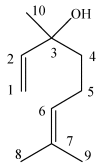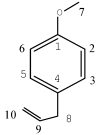Components and insecticidal activity against the maize weevils of Zanthoxylum schinifolium fruits and leaves
- PMID: 21490556
- PMCID: PMC6260620
- DOI: 10.3390/molecules16043077
Components and insecticidal activity against the maize weevils of Zanthoxylum schinifolium fruits and leaves
Abstract
In our screening program for new agrochemicals from Chinese medicinal herbs and wild plants, Zanthoxylum schinifolium essential oils were found to possess strong insecticidal activity against the maize weevil Sitophilus zeamais. The essential oils of Z. schinifolium fruits and leaves were extracted via hydrodistillation and investigated by GC and GC-MS. Estragole (69.52%) was the major compound of the essential oil of fresh fruits, followed by linalool (8.63%) and limonene (4.34%) and 94.33% of the total components were monoterpenoids. The main components of the essential oil of fresh leaves were linalool (12.94%), ar-tumerone (8.95%), limonene (6.45%) and elixene (5.43%) and only 50.62% were monoterpenoids. However, the essential oil from purchased fruits contained linalool (33.42%), limonene (13.66%) and sabinene (5.72%), followed by estragole (4.67%), nerol (4.56%) and 4-terpineol (4.27%). Estragole, linalool and sabinene were separated and purified by silica gel column chromatography and preparative thin layer chromatography, and further identified by means of physicochemical and spectrometric analysis. The essential oil from the fresh fruits (LD₅₀ = 15.93 μg/adult) possessed two times more toxicity to the insects compared with that of fresh leaves (LD₅₀ = 35.31 μg/adult). Estragole, linalool and sabinene exhibited contact activity against S. zeamais with LD₅₀ values of 17.63, 13.90 and 23.98 μg/adult, respectively. The essential oils of Z. schinifolium possessed strong fumigant toxicity against S. zeamais adults with LC₅₀ values of 13.19 mg/L (fresh fruits), 24.04 mg/L (fresh leaves) and 17.63 mg/L (purchased fruits). Estragole, linalool and sabinene also exhibited strong fumigant toxicity against the maize weevils with LC₅₀ values of 14.10, 10.46 and 9.12 mg/L, respectively.
Figures
Similar articles
-
Insecticidal activity of essential oil of Carum Carvi fruits from China and its main components against two grain storage insects.Molecules. 2010 Dec 20;15(12):9391-402. doi: 10.3390/molecules15129391. Molecules. 2010. PMID: 21173724 Free PMC article.
-
Chemical composition and insecticidal activity of the essential oil of Illicium pachyphyllum fruits against two grain storage insects.Molecules. 2012 Dec 13;17(12):14870-81. doi: 10.3390/molecules171214870. Molecules. 2012. PMID: 23519259 Free PMC article.
-
Chemical composition and insecticidal activity of the essential oil of Amethystea caerulea L.Nat Prod Res. 2012;26(13):1207-12. doi: 10.1080/14786419.2010.547195. Epub 2011 Aug 31. Nat Prod Res. 2012. PMID: 21878001
-
Composition of essential oil of Chinese Chenopodium ambrosioides and insecticidal activity against maize weevil, Sitophilus zeamais.Pest Manag Sci. 2011 Jun;67(6):714-8. doi: 10.1002/ps.2112. Epub 2011 Feb 24. Pest Manag Sci. 2011. PMID: 21360645
-
Exploring Contact Toxicity of Essential Oils against Sitophilus zeamais through a Meta-Analysis Approach.Plants (Basel). 2022 Nov 13;11(22):3070. doi: 10.3390/plants11223070. Plants (Basel). 2022. PMID: 36432799 Free PMC article. Review.
Cited by
-
Hydroxy-α-sanshool Possesses Protective Potentials on H2O2-Stimulated PC12 Cells by Suppression of Oxidative Stress-Induced Apoptosis through Regulation of PI3K/Akt Signal Pathway.Oxid Med Cell Longev. 2020 Jul 9;2020:3481758. doi: 10.1155/2020/3481758. eCollection 2020. Oxid Med Cell Longev. 2020. PMID: 32695254 Free PMC article.
-
The Chemical and Genetic Characteristics of Szechuan Pepper (Zanthoxylum bungeanum and Z. armatum) Cultivars and Their Suitable Habitat.Front Plant Sci. 2016 Apr 19;7:467. doi: 10.3389/fpls.2016.00467. eCollection 2016. Front Plant Sci. 2016. PMID: 27148298 Free PMC article.
-
Biological Activity and Chemical Composition of Essential Oil from Leaves and Fruits of Zanthoxylum mantaro (J.F.Macbr.) J.F.Macbr.Antibiotics (Basel). 2025 Feb 21;14(3):216. doi: 10.3390/antibiotics14030216. Antibiotics (Basel). 2025. PMID: 40149028 Free PMC article.
-
GC×GC-TOFMS Analysis of Essential Oils Composition from Leaves, Twigs and Seeds of Cinnamomum camphora L. Presl and Their Insecticidal and Repellent Activities.Molecules. 2016 Mar 28;21(4):423. doi: 10.3390/molecules21040423. Molecules. 2016. PMID: 27043503 Free PMC article.
-
Radiosensitizing effect of schinifoline from Zanthoxylum schinifolium Sieb et Zucc on human non-small cell lung cancer A549 cells: a preliminary in vitro investigation.Molecules. 2014 Dec 1;19(12):20128-38. doi: 10.3390/molecules191220128. Molecules. 2014. PMID: 25470278 Free PMC article.
References
-
- Zettler J.L., Arthur F.H. Chemical control of stored product insects with fumigants and residual treatments. Crop Prot. 2000;19:577–582. doi: 10.1016/S0261-2194(00)00075-2. - DOI
-
- Isman M.B. Plant essential oils for pest and disease management. Crop Prot. 2000;19:603–608. doi: 10.1016/S0261-2194(00)00079-X. - DOI
-
- Rajendran S., Srianjini V. Plant products as fumigants for stored-product insects control. J. Stored Prod. Res. 2008;44:126–135. doi: 10.1016/j.jspr.2007.08.003. - DOI
-
- The Pharmacopoeia Commission of PRChina. Pharmacopoeia of the People’s Republic of China. Vol. 1. Guangdong Science and Technology Press; Guangzhou, China: 1995. pp. 135–136.
Publication types
MeSH terms
Substances
LinkOut - more resources
Full Text Sources
Research Materials
Miscellaneous




